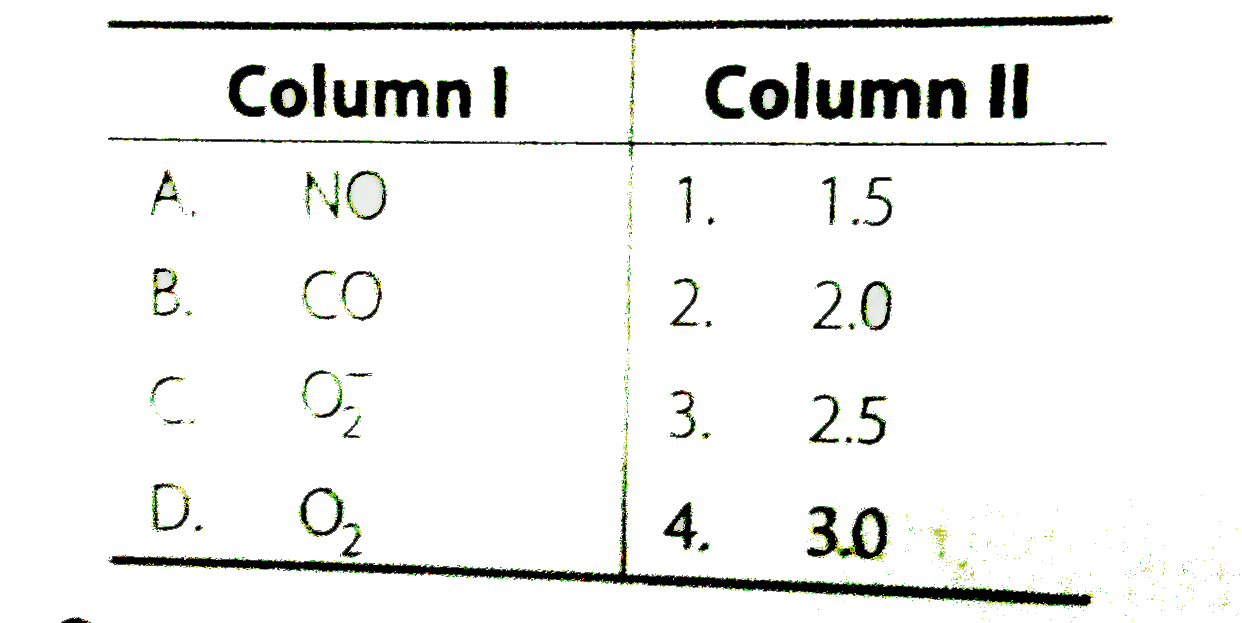The pair of species with the same bond order is :
NO, CO
N2,O2
O2−2,B2
O+2,NO+
The correct Answer is:C
To determine the pair of species with the same bond order, we can follow these steps:
Step 1: Understand Bond Order
Bond order is defined as the number of chemical bonds between a pair of atoms. It can be calculated using the formula:
Bond Order=(Number of bonding electrons−Number of antibonding electrons)2
Step 2: Identify the Given Species
The species given in the question are:
1. NOCO
2. N2O2
3. O2^2-
4. B2
5. O2^+
6. NO^+
Step 3: Calculate the Bond Order for Each Species
1. O2^2- (Oxygen Dioxide Ion)
- Total electrons = 8 (O) + 8 (O) + 2 (for 2 negative charges) = 18
- Bond order = (Number of bonding electrons - Number of antibonding electrons) / 2
- For O2^2-, the bond order is calculated as 1.
2. B2 (Boron Dimer)
- Total electrons = 5 (B) + 5 (B) = 10
- Bond order = (Number of bonding electrons - Number of antibonding electrons) / 2
- For B2, the bond order is also 1.
3. O2^+ (Oxygen Cation)
- Total electrons = 8 (O) + 8 (O) - 1 (for the positive charge) = 15
- Bond order = 2.5.
4. N2O2 (Dinitrogen Dioxide)
- The calculation is complex and generally requires molecular orbital theory, but it typically has a bond order of around 2.
5. NOCO (Nitrosyl Carbonyl)
- Similar to N2O2, this requires more complex calculations, but it generally has a bond order of around 2.
Step 4: Compare the Bond Orders
From the calculations:
- O2^2- has a bond order of 1.
- B2 has a bond order of 1.
- O2^+ has a bond order of 2.5.
- N2O2 has a bond order of around 2.
- NOCO has a bond order of around 2.
Conclusion
The pair of species with the same bond order is O2^2- and B2, both having a bond order of 1.
Final Answer
The correct option is: O2^2- and B2.
Bond order is defined as the number of chemical bonds between a pair of atoms. It can be calculated using the formula:
Bond Order=(Number of bonding electrons−Number of antibonding electrons)2
The species given in the question are:
1. NOCO
2. N2O2
3. O2^2-
4. B2
5. O2^+
6. NO^+
1. O2^2- (Oxygen Dioxide Ion)
- Total electrons = 8 (O) + 8 (O) + 2 (for 2 negative charges) = 18
- Bond order = (Number of bonding electrons - Number of antibonding electrons) / 2
- For O2^2-, the bond order is calculated as 1.
- Total electrons = 5 (B) + 5 (B) = 10
- Bond order = (Number of bonding electrons - Number of antibonding electrons) / 2
- For B2, the bond order is also 1.
- Total electrons = 8 (O) + 8 (O) - 1 (for the positive charge) = 15
- Bond order = 2.5.
- The calculation is complex and generally requires molecular orbital theory, but it typically has a bond order of around 2.
- Similar to N2O2, this requires more complex calculations, but it generally has a bond order of around 2.
From the calculations:
- O2^2- has a bond order of 1.
- B2 has a bond order of 1.
- O2^+ has a bond order of 2.5.
- N2O2 has a bond order of around 2.
- NOCO has a bond order of around 2.
The pair of species with the same bond order is O2^2- and B2, both having a bond order of 1.
The correct option is: O2^2- and B2.
Similar Questions
Knowledge Check
Which one of the following pairs of species have the same bond order?
ACO,NOBO2,NO+CCN−,CODN2,O−2
Species having same bond order are
View SolutionThe pair of species with similar shape is
View SolutionFind the pair that has the same bond order with diamagnetic and paramagnetic properties respectively.
View SolutionIn the following questions, a statement of assertion (A) is followed by a statement of reason (R )
A : N2 CO and CN− are having same bond order.
R: Isoelectronic species always have same bond order .
View SolutionAmong the following species highest bond order is of
View SolutionMatch the species in Column I with the bond order in Column II.

View SolutionWhich of the following species have same bond order and same shape
(a) NΘ3 (b) O3 (c ) CO2 (d) NOΘ2.
View Solution
